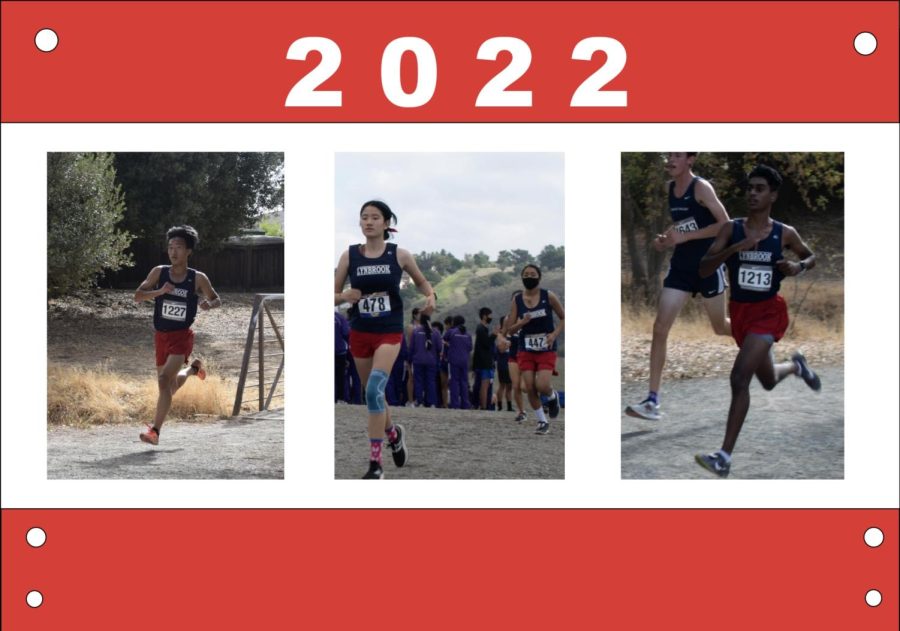Track athletes prepare for the spring season
Graphic illustration by Sports Section
Spiked shoes round the 400 meter track and the weight room machines creak in unison as Lynbrook’s track & field team prepares themselves for the spring season.
March 8, 2022
Spiked shoes round the 400 meter track and the weight room machines creak in unison as Lynbrook’s track & field team prepares themselves for the spring season. Their notoriously brutal conditioning continues throughout the year, but as competitive meets draw closer, members are preparing for three to five hours a day, six days a week.
These exhausting workouts have been critical in fostering a sense of community on the team and instilling confidence within each member. Having a scheduled time for everyone to share a goal and their love for running gives runners motivation to keep going. Track & field is a notoriously intense sport, consisting of events ranging from short and long distance running to jumping to throwing. After a couple rocky seasons due to constantly changing COVID-19 guidelines, the athletes in Lynbrook’s tight-knit track community have demonstrated increased dedication in hopes of making it to higher-level competitions. Especially for the seniors, this season represents a final opportunity to shine and savor memories made with long-time teammates.
“I’m hoping for a complete season, a season uninterrupted by the pandemic and having all opportunities available for the athletes to compete to the best of their ability,” coach Bernie Ramos said.
The meets for this season include prestigious invitationals such as the The King’s Academy, Stanford and Arcadia International, which are contingent upon their performance this season following victories at Andy Anderson on Feb. 17 in events such as the 4 x 200 relay.
Most sports, such as field hockey and soccer, begin preseason conditioning one to three months before the season begins, and these sessions are often voluntary and informal. In contrast, Lynbrook’s track & field team undergoes year-long conditioning to keep athletes in shape, and these practices gain more structure and rigor as the season draws near. Most major specialties within track & field have a designated coach who helps athletes with their goals within the event, alongside universal routines that everyone partakes in. Thus far, the 2022 pre-season preparation has consisted of four to five hours daily of running drills, track events and weight training on campus.
The sport not only takes a physical toll on bodily strength but also results in a large mental strain. Ramos emphasizes what he has dubbed “personal records” at every race, meaning that an athlete performs the best they possibly can without chasing specific times. Athletics often perpetuates a culture of perfectionism and pushing oneself to their body’s limits, but the track & field team is unique in focusing on fun and proper execution. Sleep and recovery are just as vital for a racer as building muscle and training, and the team is constantly reminded about how easily fatigue can affect performance.
“Mindset is really important for an athlete, and when they can refocus their thought process on the execution of their events that is practiced throughout the season, their sleep, recovery, nutrition and everything else should fall into place,” Ramos said.
Throughout the week’s practices, Ramos integrates mobility workouts to help with posture and injury prevention and tough workouts that often involve sprinting or building stamina. Members are divided into groups based on even, but all have relatively similar schedules: a balance between strength and targeted event training. Most practices work to build mobility through wickets or hurdles during drill workouts, which aid in ensuring that each runner has proper form. Given the intensity and regularity of these workout sessions, prioritizing flexibility and limber joints is vital to prevent injury.
“A lot of track is just fine tuning your posture so that you can shave off every millisecond,” junior and varsity track member Serena Kher said.
Known among track members to be the most sweaty and brutal are the specialized conditioning practices, which help each runner reach their full potential in events. The team is separated into long-distance runners, throwers and sprinters/jumpers/hurdlers respectively. Throwers work to enhance explosive power within the weightroom, and footwork on the track. Long-distance runners often spend this time fine tuning their aerobic system through steady state runs or interval workouts in order to improve tempo. Alternatively, sprinters and relay runners’ push workouts involve short distance runs of 60 to 200 yards. The ability to produce force is highly important, and these athletes often train at the same velocity they would at a race, as they are timed throughout.
With the recent remodel of the weight room on Lynbrook’s campus, athletic teams have made use of the utilities and machines offered to further train members. The weight room provides a relatively independent environment for athletes, leaving them free to choose within a list of upper body, leg and core workouts — each curated for a particular set of muscles. However, the risk-reward of each workout is carefully calculated before being suggested, and this has resulted in squats and deadlifts being removed from the inventory. Specifically, the team has concentrated on back, hip, and core strength this year. These workouts have proven to be worthwhile in the past, with Lynbrook frequently appearing among finalists in the Central Coast Section Championships, a regional track & field competition. In 2021, multiple athletes technically would have qualified for the state meet, but it was canceled due to safety conditions and left members seeking an opportunity to showcase their talent.
The team that sweats together sticks together, and while hours of brutal daily workouts may sound terrifying, they have heightened athletes’ abilities to work together, strengthened their performance during events and built anticipation for the season to come.



































































